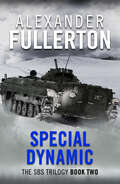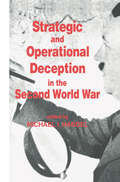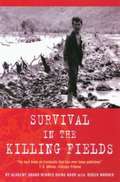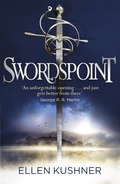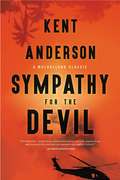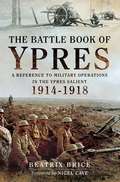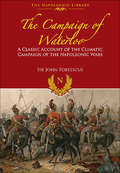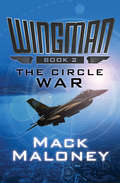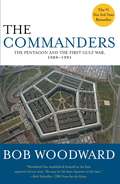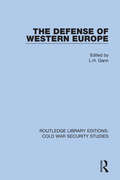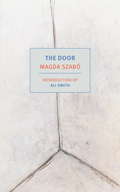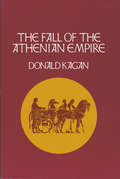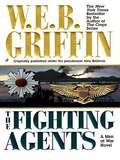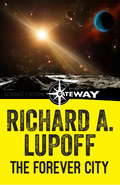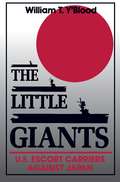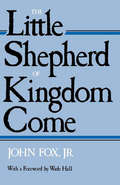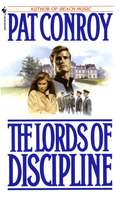- Table View
- List View
Special Dynamic (The SBS Trilogy)
by Alexander FullertonBritish special forces encounter deadly Russian operatives preparing for a subarctic invasion in this Cold War military thriller. Ollie Lyle, a former captain of Britain&’s elite Special Boat Service, is assigned to a civilian expedition into Norwegian Lapland. In that remote region of the far north, a nationalist movement&’s actions have seemingly escalated into terrorism and murder. But Lyle and his team soon discover a far more dangerous scenario unfolding. Neighboring Russia has deployed a vicious undercover operation as a prelude to a full-scale invasion. What began as a peaceful, fact-finding mission becomes a deadly struggle against two implacable enemies. Hampered by his inexperienced companions, Lyle must draw on all his combat and survival skills to stand any chance of coming out alive.
Stalin in October: The Man Who Missed the Revolution
by Robert M. SlusserOriginally published in 1987. In March 1917 young Joseph Stalin, already a high-ranking Bolshevik, returned from Siberian exile in search of greatness and power. But his activities during the months leading up to the October Revolution were full of blunders and misjudgments—failures that in later years Stalin obliterated from the historical record. Stalin in October reassembles the history of 1917 and explains why, on the eve of the revolutionaries' seizure of power, Stalin seemingly dropped out of the picture. "He would always be dogged," Slusser writes, "by a nagging sense of having somehow missed the revolution." The lingering shame was crucial to Stalin's development into a Soviet dictator.
Starlight: A Novel
by Scott ElyIn the depths of Vietnam&’s jungles, a radioman and a haunted sniper try to surviveJackson has three hundred days left in Vietnam, and he plans to spend them behind a desk, working the radio for a major in a godforsaken firebase not far from the Laos border. But one day, the reality of war visits Jackson in the form of Tom Light, a sniper whose scope is said to have the power to raise the dead. Where Light goes, ambushes follow, and so he has been cursed to wander the jungle alone, his skin growing pale, his boots replaced with sandals.Tom Light is a dangerous man to know, a spooky lost soldier who survives in spite of himself. Jackson wants to learn his secret. Hoping the master sniper can keep him safe, Jackson ventures out with Light. In the jungle they will encounter perils—some real and some hallucinatory. Can the strange sniper&’s all-powerful starlight scope will them to stay alive?
Strategic and Operational Deception in the Second World War (Studies in Intelligence)
by Michael I. HandelFirst Published in 1987. Routledge is an imprint of Taylor & Francis, an informa company.
Studies in Public Enterprise: From Evaluation to Privatisation (Routledge Library Editions: Public Enterprise And Privatization Ser.)
by V. V. RamanadhamFirst Published in 1987. Routledge is an imprint of Taylor & Francis, an informa company.
Survival in the Killing Fields
by Haing Ngor Roger WarnerNothing has shaped my life as much as surviving the Pol Pot regime. I am a survivor of the Cambodian holocaust. That's who I am," says Haing Ngor. And in his memoir, Survival in the Killing Fields, he tells the gripping and frequently terrifying story of his term in the hell created by the communist Khmer Rouge. Like Dith Pran, the Cambodian doctor and interpreter whom Ngor played in an Oscar-winning performance in The Killing Fields, Ngor lived through the atrocities that the 1984 film portrayed. Like Pran, too, Ngor was a doctor by profession, and he experienced firsthand his country's wretched descent, under the Khmer Rouge, into senseless brutality, slavery, squalor, starvation, and disease-all of which are recounted in sometimes unimaginable horror in Ngor's poignant memoir. Since the original publication of this searing personal chronicle, Haing Ngor's life has ended with his murder, which has never been satisfactorily solved. In an epilogue written especially for this new edition, Ngor's coauthor, Roger Warner, offers a glimpse into this complex, enigmatic man's last years-years that he lived "like his country: scarred, and incapable of fully healing. "
Swordspoint
by Ellen KushnerOn the treacherous streets of Riverside, a man lives and dies by the sword. Even the nobles on the Hill turn to duels to settle their disputes. Within this elite, dangerous world, Richard St Vier is the undisputed master, as skilled as he is ruthless- until a death by the sword is met with outrage instead a of awe, and the city discovers that the line between hero and villain can be altered in the blink of an eye . . .
Sympathy for the Devil
by Kent AndersonCensured by some critics for its brutality but heralded by others as a modern-day classic, Sympathy for the Devil is a terrifying, intoxicating journey through the violence, madness, and insane beauty of battle. It traces the story of a hardened Green Beret named Hanson, a college student who goes to war with a book of Yeats's poetry in his pocket and discovers the savagery within himself. In this extraordinary novel, we follow Hanson through two tours of duty and a bitter attempt to live as a civilian in between. At one with the lush and dangerous world around him in Vietnam, Hanson is doomed to survive the landscape of devastation he encounters. Sympathy for the Devil contains some of the most vivid, finely etched prose ever written about the actual process of war--from firing a weapon for the first time in battle to the moment a young man knows that he has entered a living hell and found a home....
Sympathy for the Devil (Mulholland Classic)
by Kent AndersonKent Anderson's stunning debut novel is a modern classic, a harrowing, authentic picture of one American soldier's experience of the Vietnam War--"unlike anything else in war literature" (Los Angeles Review of Books).Hanson joins the Green Berets fresh out of college. Carrying a volume of Yeats's poems in his uniform pocket, he has no idea of what he's about to face in Vietnam--from the enemy, from his fellow soldiers, or within himself. In vivid, nightmarish, and finely etched prose, Kent Anderson takes us through Hanson's two tours of duty and a bitter, ill-fated return to civilian life in-between, capturing the day-to-day process of war like no writer before or since.
The American Experience in Vietnam: Reflections on an Era
by The Editors of Boston Publishing CompanyThe landmark, Pulitzer Prize–nominated, bestselling illustrated history, updated for the fiftieth anniversary of the Vietnam War.When it was originally published, the twenty-five-volume Vietnam Experience offered the definitive historical perspectives of the Vietnam War from some of the best rising authors on the conflict. This new and reimagined edition updates the war on the fifty years that have passed since the war’s initiation. The official successor to the Pulitzer Prize–nominated set, The American Experience in Vietnam combines the best serious historical writing about the Vietnam War with new, never-before-published photos and perspectives. New content includes social, cultural, and military analysis; a view of post-1980s Vietnam; and contextualizing discussion of US involvement in the Persian Gulf, Iraq, and Afghanistan. Even if you own the original, The American Experience in Vietnam is a necessary addition for any modern Vietnam War enthusiast.Praise for The American Experience in Vietnam“The heart of the book is a well-written, objectively presented history of the war that includes a lot of military history.” —Vietnam Veterans of America
The Battle Book of Ypres: A Reference to Military Operations in the Ypres Salient 1914–1918
by Beatrix BriceOf the many hard-fought battles on the Western Front, Ypres stands out as an example of almost inhuman endeavour. For four long years it was the focal point of desperate fighting. Officially there were four main battles in 1914, 1915, 1917 and 1918; these were more accurately peaks in a continuing struggle, for Ypres symbolised Belgian defiance, and the British continued to expend disproportionate resources on defending it. It never fell, although the Germans came close to its gates, and indeed its loss would have been a severe blow to morale.The Battle Book of Ypres, originally published in 1927 and now presented again as a special Centenary Edition, comprises a chronological account of the fighting in the Ypres Salient during the First World War, followed by a useful and unique alphabetical reference to the events in and around each hamlet, village or wood names familiar to those who fought or followed the course of war all those years ago, names now once again lost in insignificance. The names given to each stage of the struggle by the Battle Nomenclature Committee are listed in the appendix. Also included is an index of formations and units, an annotated bibliography and a new Foreword by military historian Nigel Cave.
The British Army since 2000
by Peter Dennis James TannerFrom the First Gulf War in Iraq to the ongoing war in Afganistan the British Army has undergone massive changes in everything from mission capabilities to equipment.Fully illustrated and written by an insider, this engaging book traces the major transformations in British Army doctrine, organization, structures, units, uniforms and equipment, from the end of the Cold War in the 1990s up to today. Since the end of the Cold War in 1991, the British Army has undergone deep and widespread changes, including the creation of new units and capabilities, as well as cuts and amalgamations. It has digested these changes while simultaneously fighting in two major expeditionary wars (one of them ongoing) and in several lesser overseas deployments. While small by superpower standards, it continues to "punch above its weight," and is unquestionably the most experienced (indeed, virtually the only experienced) fighting force in Europe. It remains the only NATO ally which the USA can rely on to contribute significant combat forces for expeditionary campaigns.
The Campaign of Waterloo: The Classic Account of Napoleon's Last Battles
by John FortescueThe Campaign of Waterloo is the complete account of the climatic campaign and battle of the Napoleonic Wars abstracted from Sir John Fortescues monumental A History of the British Army.Issued as an independent volume, The Campaign of Waterloo chronicles the events from Napoleons exile to Elba on 28 April 1814 to his departure from France on 15 July 1815 and exile on St Helena.Between those dates was the Campaign of Waterloo and the final, ferocious battle of 18 June 1815 which destroyed Napoleons power. Fortescues analytical approach, strips away the mysterious and complexities of the campaign to allow readers a clear understanding of this short but epoch-changing series of events.The classic history Anthony Bruce, A Bibliography of the British Army
The Circle War: Wingman, The Circle War, The Lucifer Crusade, Thunder In The East (Wingman #2)
by Mack MaloneyFlying over a shattered nation, ace pilot Hawk Hunter comes face to face with his greatest enemyThe United States may have defeated the Soviet Union in the Battle for Western Europe, but the Russians ended World War III with a nuclear sneak attack that shattered America into a collection of warring states dominated by criminals, fascists, and pirates. Air power rules all in the New Order, and pilots like Hawk Hunter are the only form of law. One of the most decorated pilots of the old US Air Force, he flies for the Pacific American Air Corps, a loose group of flyboys who have taken it upon themselves to safeguard what remains of US borders. Flying his U-2 over the frozen tundra late one night, Hunter detects something on his infrared camera: fifty jet fighters, accompanied by a full-scale invasion force. And their sides bear the emblem that frightens him most: the red star of the Soviet Union. World War IV is about to begin. The Circle War is the second book of the Wingman series, which also includes Wingman and The Lucifer Crusade.
The Commanders
by Bob WoodwardIt is impossible to examine any part of the war on terrorism in the twenty-first century without seeing the hand of Dick Cheney, Colin Powell or one of their loyalists. The Commanders, an account of the use of the military in the first Bush administration, is in many respects their story--the intimate account of the tensions, disagreements and debates on the road to war.It is impossible to examine any part of the war on terrorism in the twenty-first century without seeing the hand of Dick Cheney, Colin Powell or one of their loyalists. The Commanders, an account of the use of the military in the first Bush administration, is in many respects their story--the intimate account of the tensions, disagreements and debates on the road to war.
The Defense of Western Europe (Routledge Library Editions: Cold War Security Studies #22)
by L. H. GannThis book, first published in 1987, examines the defence forces of Western Europe and assesses Europe’s capacity to defend itself as the 1980s saw the Cold War balance of power shift towards the Soviet Union. Soviet forces were greatly superior to NATO’s in terms of tanks, artillery and combat divisions, and this book analyses the NATO response and capabilities.
The Deluge Drivers (Gateway Essentials #525)
by Alan Dean FosterJust when it looked as if Ethan Fortune might be able to breathe a warm sigh of relief at getting away from the icy world of Tran-ky-ky, he was ordered to stay right where he was. It seemed the scientists at the outpost of Brass Monkey had spotted something odd - an isolated and ominous atmosphere hot spot far to the south. Only Ethan, along with the huge, hell-raising Skua September, had the local knowledge and the persuasiveness to get the Tran to mount an expedition. Only the giant icerigger Slanderscree could cope with the conditions. Knowing you're wanted may warm the cockles of the human heart but Ethan knew at once that the rest of him was going to be exposed to freezing cold, considerable danger and a whole lot more of the adventures that kept coming his way...
The Door
by Ali Smith Len Rix Magda SzaboAn NYRB Classics Original Winner of the Oxford-Weidenfeld Translation Prize and the Prix Femina ÉtrangerThe Door is an unsettling exploration of the relationship between two very different women. Magda is a writer, educated, married to an academic, public-spirited, with an on-again-off-again relationship to Hungary's Communist authorities. Emerence is a peasant, illiterate, impassive, abrupt, seemingly ageless. She lives alone in a house that no one else may enter, not even her closest relatives. She is Magda's housekeeper and she has taken control over Magda's household, becoming indispensable to her. And Emerence, in her way, has come to depend on Magda. They share a kind of love--at least until Magda's long-sought success as a writer leads to a devastating revelation. Len Rix's prizewinning translation of The Door at last makes it possible for American readers to appreciate the masterwork of a major modern European writer.
The Fall of the Athenian Empire (A New History of the Peloponnesian War)
by Donald KaganIn the fourth and final volume of his magisterial history of the Peloponnesian War, Donald Kagan examines the period from the destruction of Athens' Sicilian expedition in September of 413 B.C. to the Athenian surrender to Sparta in the spring of 404 B.C. Through his study of this last decade of the war, Kagan evaluates the performance of the Athenian democracy as it faced its most serious challenge. At the same time, Kagan assesses Thucydides' interpretation of the reasons for Athens' defeat and the destruction of the Athenian Empire.
The Fighting Agents (Men at War #4)
by W.E.B. GriffinThe Philippines, 1943: As the ragged remnants of the American forces stand against the might of the Imperial Japanese Army, a determined cadre of OSS agents becomes their only contact with the outside world-and their only hope for survival.<P><P> In Budapest, an agent must keep two key prisoners from being interrogated by the Gestapo, his only choice to rescue them - or kill them. In Washington, an Army Air Corps captain suddenly finds himself assigned deep under the sea, his mission an improbable one involving submarines, supplies, arms, and gold. And in Cairo, an undistinguished pilot named Darmstadter wonders why in the world the OSS is interested in his services, only to find out in the most dramatic way possible - and become a hero in the process.
The Forever City
by Richard A. LupoffTeenage camera operator Alfonso Petrov joins a research mission bound for the edge of the solar system. But survival becomes another mission when the research team's tiny spacecraft strays into the Fiction Dimension. A madcap tale blending classic science fiction with Gothic horror.
The Forge in the Forest (Gateway Essentials #293)
by Michael Scott RohanThe siege of Kerbryhaine had been raised, the Ekwesh hordes vanquished, the Mastersmith slain. But for Alv - now Elof the Smith - the war was not yet won: Kerbryhaine was still a divided city; the Ekwesh, bloodily defeated, would look for revenge; and the Ice, implacably malevolent, continued its inexorable march southward. So from divided Kerbryhaine Elof, Kermorvan and his companions mounted an expedition to the legendary lost cities of the East; if they managed to reunite the war-torn tribes, perhaps they could stand together against the menace of the Ice. But to Elof and Kermorvan the journey would also bring knowledge: of the Powers ranged for and against them; and the secrets within themselves waiting to be revealed - secrets that would play a part in the war yet to come.
The Little Giants
by William T. Y'BloodThe substantial accomplishments of the U.S. Navy's mini-carriers in such battles as Leyte Gulf, Guadalcanal, the Marianas, and Okinawa never gained the attention given the fast carriers, but there is little question that their vital operations played an important role in the Pacific campaign. These remarkably versatile vessels--called CVEs, baby flattops, and even jeeps--hunted submarines, escorted convoys, provided air support, and performed dozens of other tasks that are vividly described in this book. Based on interviews with the CVE crewmen and on war diaries, ship histories, and other documents, it tells a moving story of escort carrier operations, from the work of the first CVEs to their final assignment transporting GIs home after the war. Seldom-seen photographs add to this fascinating portrait of the little giants.
The Little Shepherd of Kingdom Come (The\best Sellers Of 1903 Ser.)
by John Jr. FoxThe bestselling turn-of-the-century classic. A novel that &“makes one realize as never before the agonizing effects of the Civil War in a border state&” (The New York Times). First serialized in Scribner&’s Magazine in 1903, The Little Shepherd of Kingdom Come is the rags-to-respectability saga of Chad Buford, an orphan of questionable parentage from the Cumberland Mountains. He is befriended first by the kind and generous Turner family in the valley of Kingdom Come Creek in Southeastern Kentucky and then by the aristocratic Major Calvin Buford in the &“settlemints&” of the Bluegrass. Convinced that Chad is a kinsman, the major discovers the poor boy&’s blueblood pedigree and persuades him to pursue a proper education in Lexington. Before, however, he can settle down with an appropriate wife and begin to live the life of &“Chadwick Buford, Gentleman,&” the Civil War intervenes to separate him from his newfound status, family, and friends. In The Little Shepherd of Kingdom Come, &“the war and its conflicts set an epic stage for the novel&’s main business, the testing and maturation of a hero&” (Kentucky Living).
The Lords of Discipline
by Pat ConroyThis powerful and breathtaking novel is the story of four cadets who become blood brothers. Together they encounter the hell of hazing and the rabid, raunchy and dangerously secretive atmosphere of an arrogant and proud military institute. They experience the violence. The passion. The rage. The friendship. The loyalty. The betrayal. Together, they brace themselves for the brutal transition to manhood... and one will not survive. With all the dramatic brilliance he brought to The Great Santini, Pat Conroy sweeps you into the turbulent world of these four friends -- and draws you deep into the heart of his rebellious hero, Will McLean, an outsider forging his personal code of honor, who falls in love with a whimsical beauty and who undergoes a transition more remarkable then he ever imagined possible.
